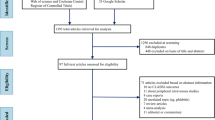Abstract
Background
The clinical use of port catheters has become widespread because they provide a safe and easy vascular route. Such widespread use of vascular port catheters has revealed early and late complications.
Aim
This study was evaluated the early and late noninfectious complications and present precautions and pitfalls to handle these complications.
Methods
The retrospective observational study comprised 801 vascular port catheters inserted into 782 adult patients for various reasons between 2010 and 2018. Patient demographic, indications for port catheter implantation, port catheter types, and insertion sides were noted. Port catheter implantation related early and late complications were recorded.
Results
The subclavian vein was selected as a target vein in almost all of the interventions (98.9%). Similarly, right-sided veins were used in about 90% of patients. The most common problem was technical issues related to the interventions. If venous cannulation was challenging, ultrasonography and fluoroscopy guidance roadmap technique were used. Most serious complication was pneumothorax in 7 patients. In the late period, the most common problem was thrombotic occlusion of the catheter. In two-thirds of these patients, thrombolytic therapy for thrombosed port catheters may rescue some catheters and avoid secondary port catheter insertions.
Conclusions
Despite these benefits, port catheters are associated with various complications. However, most of these complications can be effectively prevented by proper techniques and easily applied precautions.





Similar content being viewed by others
References
Niederhuber JE, Ensminger W, Gyves JW, Liepman M, Doan K, Cozzi E (1982) Totally implanted venous and arterial access system to replace external catheters in cancer treatment. Surgery. 92:706–712
Biffi R, Toro A, Pozzi S, Di Carlo I (2014) Totally implantable vascular access devices 30 years after the first procedure. What has changed and what is still unsolved? Support Care Cancer 22:1705–1714
Zaghal A, Khalife M, Mukherji D, El Majzoub N, Shamseddine A, Hoballah J et al (2012) Update on totally implantable venous access devices. Surg Oncol 21:207–215
Ramsay MA, Savege TM, Simpson BR, Goodwin R (1974) Controlled sedation with alphaxalone-alphadolone. Br Med J 2(5920):656–659
McGee DC, Gould MK (2003) Preventing complications of central venous catheterization. N Engl J Med 348:1123–1133
Mudan S, Giakoustidis A, Morrison D, Iosifidou S, Raobaikady R, Neofytou K et al (2015) 1000 Port-A-Cath (R) placements by subclavian vein approach: single surgeon experience. World J Surg 39:328–334
Di Carlo I, Pulvirenti E, Mannino M, Toro A (2010) Increased use of percutaneous technique for totally implantable venous access devices. Is it real progress? A 27-year comprehensive review on early complications. Ann Surg Oncol 17:1649–1656
Tabatabaie O, Kasumova GG, Eskander MF, Critchlow JF, Tawa NE, Tseng JF (2017) Totally implantable venous access devices: a review of complications and management strategies. Am J Clin Oncol 40:94–105
Biffi R, Orsi F, Pozzi S, Pace U, Bonomo G, Monfardini L et al (2009) Best choice of central venous insertion site for the prevention of catheter-related complications in adult patients who need cancer therapy: a randomized trial. Ann Oncol 20:935–940
Yanik F, Karamustafaoglu YA, Karatas A, Yoruk Y (2018) Experience in totally implantable venous port catheter: analysis of 3,000 patients in 12 years. Turk Gogus Kalp Damar Cerrahisi Derg 26:422–428
Barbetakis N, Asteriou C, Kleontas A, Tsilikas C (2011) Totally implantable central venous access ports. analysis of 700 cases. J Surg Oncol 104:654–656
Silberzweig JE, Cooper JM, Podolak MJ, Grossman GD, Patterson JL, Mitty HA (1996) Venography in the lordotic projection to facilitate central venous access. J Vasc Interv Radiol 7:439–440
Plumhans C, Mahnken AH, Ocklenburg C, Keil S, Behrendt FF, Gunther RW et al (2011) Jugular versus subclavian totally implantable access ports: catheter position, complications and intrainterventional pain perception. Eur J Radiol 79:338–342
Grannan KJ, Taylor PH (1990) Early and late complications of totally implantable venous access devices. J Surg Oncol 44:52–54
Kim JT, Oh TY, Chang WH, Jeong YK (2012) Clinical review and analysis of complications of totally implantable venous access devices for chemotherapy. Med Oncol 29:1361–1364
Orci LA, Meier RP, Morel P, Staszewicz W, Toso C (2014) Systematic review and meta-analysis of percutaneous subclavian vein puncture versus surgical venous cutdown for the insertion of a totally implantable venous access device. Br J Surg 101:8–16
Dariushnia SR, Wallace MJ, Siddiqi NH, Towbin RB, Wojak JC, Kundu S, Cardella JF, Society of Interventional Radiology Standards of Practice Committee (2010) Quality improvement guidelines for central venous access. J Vasc Interv Radiol 21:976–981
Muncie C, Herman R, Collier A, Berch B, Blewett C, Sawaya D (2018) Wound complications after chemo-port placement in children: does closure technique matter? J Pediatr Surg 53:572–575
Fish A, Rollins MR, Langley P, King M, Forney C, Josephson CD, Fasano RM (2018) Twiddler's syndrome in an adolescent female with an apheresis port. Transfusion. 58:280–281
Forauer AR, Chen Y, Parks R (2005) A case of posttraumatic Twiddler's syndrome. J Vasc Interv Radiol 16:562–563
Gebarski SS, Gebarski KS (1984) Chemotherapy port "Twiddler's syndrome". A need for preinjection radiography. Cancer. 54:38–39
Author information
Authors and Affiliations
Corresponding author
Ethics declarations
Declarations
The manuscript has not been published or presented elsewhere in part or in entirety and it is not under consideration by another journal.
Ethical approval
It was obtained from the institutional Local Ethics Committee for the current study. We have read and understood your journal’s policies, and we believe that neither the manuscript nor the study violates any of these.
Conflict of interest
There are no conflicts of interest to declare. All authors have participated in the work and could publicly defend its contents, and have read the manuscript prior to its submission for publication and agree with its contents.
Additional information
Publisher’s note
Springer Nature remains neutral with regard to jurisdictional claims in published maps and institutional affiliations.
Rights and permissions
About this article
Cite this article
Ince, M.E., Ozkan, G., Ors, N. et al. Complications and pitfalls of central venous port catheters: experience with 782 patients with cancer. Ir J Med Sci 189, 1371–1377 (2020). https://doi.org/10.1007/s11845-020-02207-5
Received:
Accepted:
Published:
Issue Date:
DOI: https://doi.org/10.1007/s11845-020-02207-5




